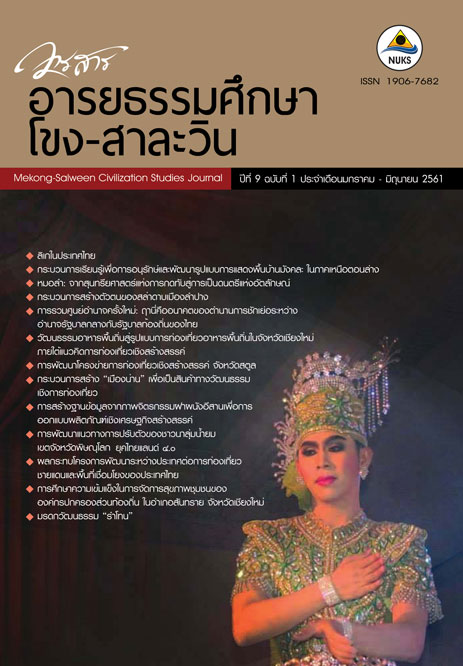The commodification process of cultural tourism in Nan District กระบวนการสร้าง "เมืองน่าน" เพื่อเป็นสินค้าทางวัฒนธรรมเชิงการท่องเที่ยว
Main Article Content
บทคัดย่อ
The objective of this article is to study the process of cultural commodification of Nan’s Muang district for which the cultural identities and cultural capitals of the town are commoditized for the purpose of tourism by relevant stakeholders. The study is aimed to ;1) understand how social and cultural capitals of Muang Nan District are converted to cultural goods for tourism industry2) to study the adaptation process of stakeholders in response to the government’s cultural commodification policy, and to understand its subsequent impacts on those stakeholders in Muang Nan district. Theoretical frameworks used for this qualitative study were cultural tourism, social and cultural capitals and creative tourism. Sampled populations were governmental agencies, private sectors, local communities in Muang Nan district and tourists who visited the area. The studied area was Nan’s old town which encompasses places of interest such as the National Museum of Nan and Phumin Temple. The study revealed that state’s tourism promotion policies were instrumental to the commodification process which initiated by trend building, sourcing cultural identities, meaning creations, product presentations, and adaptations of relevant stakeholders. As a result, the meaning of cultural capitals has been modified through the process of reproductions which resulted in valuable commercial gains.
Downloads
Article Details
เอกสารอ้างอิง
Aphinya (alias). Academician, Nan Provincial Culture Office. Interviewed on March 18, 2016.
Bourdieu, P. (1977). Outline of a Theory of Practice, Cambridge University Press, UK.
Buahapakdee, A. (2003). Unseen of Thailand. TAT’s magazine. 43(10), 20-23.
Department of Fine Arts. (1987). Muang Nan history, archeology and art, Amarin Printing Group Company, Bangkok.
Chuaybamrung, T. (2009). The role of local government organizations and sustainable tourism development on the basis of sufficiency economy, King Prajadhipok's Institute, Bangkok.
Kitiarsa, P. (2003). Thai collection social science, (1-49). Plan Print Ltd. Company, Bangkok.
Kusumawadee, S. (2015). Creative Economy, V. printing Ltd. Company (1991), Bangkok.
McKercher, Bob and Hilary du Cros. (2002). Culture Tourism: the partnership between tourism and culture heritage management. United States of America: The Haworth Press.
Nan’s Cultural Office. (2011), Nan’s old town relive series: Nan’s old town, Nan.
Nan Provincial Administrative Office and Nan’s Cultural Office. (2009). Master Plan Conservation and development of Old Town, Nan.
Nan Museum. Wat noi. search 1 November 2016, form :https://biwtoom.wordpress.com.
Ooi, Can-Seng. (2013). Tourism policies challenges Balancing acts, co-operative stakeholders and maintain authenticity. In Melanie Smith and Greg Richards, The Rout ledge Handbook of Culture Tourism, (67-81). New York: Routledge.
Pattarapon (alias). Tourist at National Museum of Nan. Interviewed on November 4, 2016.
Piti (alias). President of Provincial Administrative Organization, Nan’s Provincial Administrative Center. Interviewed on January 5, 2016.
Prakran (alias). entrepreneur of Huen Hom Restaurant. Interviewed on January 28, 2016.
Thatsanasuwan, P. (1962). Nan River rafting. TAT’s magazine. 2(8), 67. The Foto United Club, Photography Group.
Wiwatthanavanit, W. Nan’s Former governor (2009-2010).


